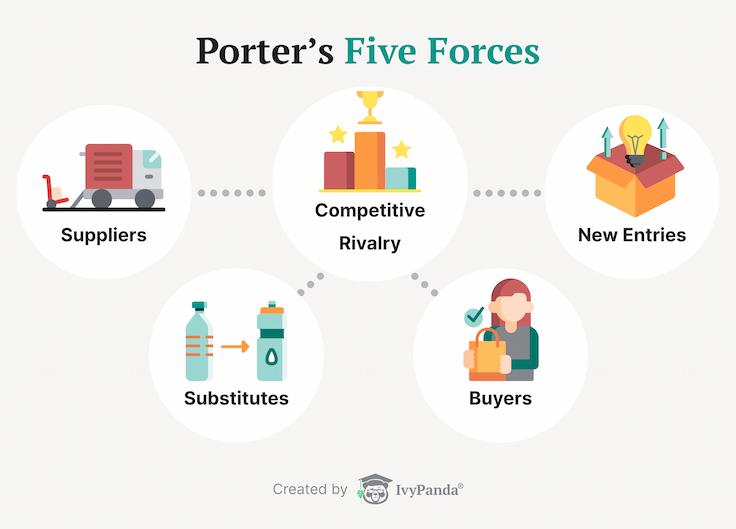5 Forces Analysis Template
Get a customized report with this 5 Forces analysis template in 3 steps: fill in the fields, choose your favorite template, and download the result!
⚙️ Porter’s 5 Forces Model: How Does It Work?
Already determined the five forces that influence the business you’re analyzing? Ready to illustrate your points? Let’s see how to use the 5 Forces analysis template!
- Fill in the blanks. Since Porter identified five essential forces, there are only five sections you should complete. They are listed on the left.
- Select a design. Choose what your matrix will look like. In the Settings, find the type you prefer by clicking each one and reviewing them in the Preview.
- Pick a color. Decide on the color palette of your 5 Forces model.
- Download the result! Select the format you prefer and click it to save the file. You can also get a free template to fill out later.
❓ 5 Forces Analysis Template – FAQ
📖 Competitive Forces Matrix Explained
Porter's Five Forces refer to a model a business can use to gain a competitive advantage in its market niche. Here, we have explained why and how it can be used.
In 1979, Michael Porter created the Five Forces of Competitive Position Analysis. It is a basic framework for measuring and assessing a business’ strength and position in the industry. The theory is based on the idea that only five forces influence a market’s competitive intensity.

- Our template will allow you to understand the competition within a particular industry. You will be able to develop efficient strategies designed to boost profits.
- Businesses can reveal the internal and external factors influencing their success with the Five Forces model. The matrix is excellent for analyzing any company, whether it is a small e-commerce website or a large corporation.
- Finally, the framework helps companies make informed decisions when entering a specific market.
⚖️ Porter's Five Forces Model - Advantages and Disadvantages
As with any analysis framework, Porter’s model has advantages and limitations. We have discussed them here. For more information, you can check free essay samples with this analysis.
5 Forces Analysis: Benefits
- Determines who has power. Five Forces show who (e.g., suppliers, purchasers, rivals) has more or less influence. In addition, it allows a business to decide on the best strategy for dealing with them.
- Identifies strengths and dangers. The framework helps figure out where the company's significant assets lie and where the threat exists. It lets the people in charge take preventative measures.
- Finds openings to expand. Porter’s Five Forces illustrates the power of suppliers and buyers in the industry. It is a great way to decide on vertical integration.
- Lays down a strategy and vision. A good plan assists in making strategic management decisions on how to produce the greatest value. The framework can provide critical information for making the firm’s approach precise.
5 Forces Analysis: Limitations
- Isn’t ideal for prominent companies. This framework is mainly designed for businesses within a single industry. If they have multiple different products or provide a large variety of services, it is not as exact.
- Doesn’t consider external factors. Some influences are not present in this framework. This model only samples known, well-established factors. Thus, it doesn’t account for natural catastrophes (e.g., some locations are more prone to them) or inflation.
- Isn’t suitable for all business areas. Although it is a great tool for industry analysis for many, the model has its limitations in some industries. For example, Porter’s Five Forces analysis will not be as helpful for non-profits.
👀 5 Forces Essay Examples
Now that you know all the ins and outs of Porter’s Five Forces, it’s time to see how you can use it practically. Click on the links and see successful essay examples of business analysis.
🌐 Porter’s Five Forces Analysis on the Hospitality Industry
🌐 The Five Forces Analysis of the Low-Cost Airline Industry in Europe Report
🌐 Empire Technology Solutions Company’s Strategy Report
🌐 Five-Forces Model in Google Essay
🌐 Amazon Company: Porter’s Five Competitive Forces Essay
🌐 Abu Dhabi National Oil Company’s Light & Heavy Vehicle Transportation Research Paper
Thank you for reading! Feel free to try out this 5 Forces analysis template and send it to your friends if you think they might need them. Also, you can use other tools we have, like SOAR template, VRIO analysis, SWOT chart, and PESTLE maker.
Updated: